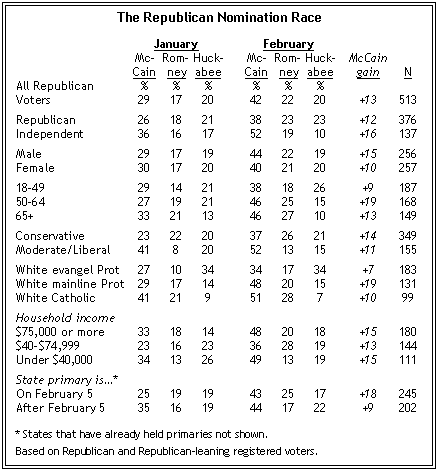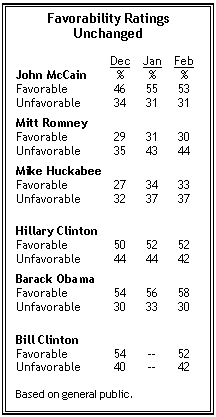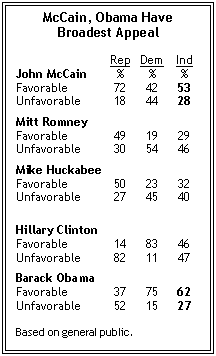Summary of Findings

Barack Obama and John McCain have made significant gains in support as the field of candidates has narrowed in both parties. John McCain now leads 42%-22% over Mitt Romney among Republican voters nationally. Support for McCain is up 13 points since mid-January, and he currently draws about twice as much support as either Romney or Mike Huckabee.
Among Democrats, Hillary Clinton’s nationwide lead over Barack Obama has been cut in half since mid-January — from 15 points then to eight points currently. Clinton’s support is unchanged since then at 46%; currently, 38% favor Obama, up from 31% three weeks ago. This suggests that the Illinois Democrat may have garnered a significant share of John Edwards’ support. However, it is important to note that the number of undecided Democratic voters has increased as well in recent weeks.

Since mid-January, Obama has made notable gains in support among whites, especially white men, political moderates, and middle-income voters. However his strongest backers continue to be African Americans, liberals, Democratic-leaning independents, and well-educated, affluent Democrats. Clinton’s greatest levels of support come from women, older voters, conservative Democrats, as well as less educated and poorer Democrats.
The latest national survey by the Pew Research Center for the People & the Press, conducted Jan. 30-Feb. 2 among 1,502 adults, finds no evidence that acrimony between Clinton and Obama during the course of the campaign has soured Democratic voters on the candidates. Democratic voters remain far more enthusiastic than Republicans about the quality of their candidates, and the favorability ratings for both Clinton and Obama among Democratic voters are virtually unchanged over the past month.

Twice as many Obama supporters have a favorable, rather than an unfavorable, impression of Clinton (62% vs. 31%). By the same two-to-one margin (60%-30%), Clinton supporters express favorable opinions of Obama. This mutual appreciation on the Democratic side stands in contrast to the Republicans; McCain is the only remaining GOP candidate who is viewed favorably by majorities of supporters of his main rivals.
Bill Clinton’s favorability rating also has not slipped from where it stood in late December. However, some voters are growing increasingly uncomfortable with the idea of Bill Clinton being “back in the White House” if Hillary were to win the election. Currently, 41% express this negative assessment, up from 34% in October. Most notably, more independents now dislike than like the idea of Bill Clinton being back in the White House, a reversal from four months ago.

The new poll also finds that the nominating contests are unfolding against a backdrop of growing public dissatisfaction with national conditions. Only about a quarter of Americans (24%) say they are satisfied with the way things are going in the country, while 70% are dissatisfied — the highest percentage expressing a negative view of national conditions in nearly 12 years (70% in March 1996).
Just 17% of Americans rate the nation’s economy as excellent or good, while 81% view the economy as only fair or poor. As recently as last month, 26% rated the economy as good or excellent. Economic ratings briefly fell to this level in early 2003, according to the Gallup Poll’s long term trends, but has not been this low consistently since 1993.
The Changing Democratic Contest
Barack Obama has made substantial gains among Democratic voters nationwide; on the eve of the Iowa caucuses just 26% of Democrats supported him, compared with 38% today. Meanwhile, the share backing Hillary Clinton has not changed — 46% of Democrats supported her on the eve of the Iowa caucuses, and 46% support her today.

While Obama has long been competitive with Clinton among younger Democrats, his current standing reflects substantial gains among middle-aged voters who, in the past, were clearly behind Clinton. In addition, Clinton held a 20-point lead among moderate Democrats as recently as mid-January; currently, Obama nearly equals Clinton’s support among moderate Democrats (44% Clinton vs. 40% Obama). As was the case in mid-January, liberal Democrats are split evenly between the two candidates; in December, Clinton held a wide lead among liberal Democratic voters (49% to 27%). Conservatives, who make up nearly a quarter of Democratic voters, continue to favor Clinton by a wide margin (56% to 28%).
Clinton holds a five-point lead among Democrats under age 50, but she is now tied with Obama among those ages 50 to 64 (41% Obama vs. 40% Clinton). Just three weeks ago Clinton held a 13-point lead among voters in this age group. While Clinton still holds a substantial 55% to 21% lead among voters ages 65 and older, Obama has won supporters here as well, as just 15% backed him three weeks ago.
Obama’s gains among middle-class Democrats is equally notable. While he has consistently challenged Clinton for the lead among Democratic voters with household incomes of $75,000 or more (he holds a modest 46% to 40% advantage over Clinton in this group today), Clinton previously held a wide lead among middle-income Democratic voters. But Obama now trails Clinton by just five points (43% to 38%) among those with annual household incomes of between $40,000 and $75,000. Clinton had a 23-point edge in this group three weeks ago. Democrats with annual household incomes of less than $40,000 continue to back Clinton by a wide margin.
Despite the racial overtones surrounding the South Carolina primaries, the gap in the candidate preferences of black and white Democratic voters has, if anything, narrowed. Obama has gained 10 points among white Democratic voters since mid-January (to 36% from 26% then). White men, in particular, have moved toward Obama in recent weeks. Currently, about as many white men back Obama (45%) as support Clinton (42%), while Clinton holds a wide 53% to 28% lead among white women. The preferences of black Democrats have not changed substantially.
McCain Gains Across the Board
McCain holds a substantial lead among all segments of the Republican electorate, with the sole exception of white evangelical Protestants. Huckabee equals McCain’s support among these voters (34% each). McCain now holds a 37% to 26% lead over Romney among conservative Republican voters, and wins the support of a majority (52%) of moderate and liberal Republican voters.
While McCain’s earlier victories in New Hampshire and South Carolina were assisted by his strong backing from independent voters, McCain’s ability to win in Florida’s “closed” Republican primary is reflected in the current national figures. He continues to hold a commanding lead among independents who “lean” toward the Republican Party, but also has opened a 15-point lead over Romney (38% to 23%) among those who consider themselves Republicans.


Besides leading in the horserace, McCain is the candidate most likely to unite the Republican base. McCain is the only candidate of the three who is viewed favorably by both Huckabee’s supporters (61%) and Romney’s supporters (59%). In contrast, Huckabee’s backers are divided in their view of Romney (41% unfavorable vs. 37% unfavorable). And Romney’s supporters are equally ambivalent about Huckabee (44% favorable vs. 39% unfavorable).
Republicans Remain Dissatisfied
Despite the consolidation of support within the party behind McCain, Republican voters remain substantially less satisfied than Democratic voters with the choices available to them. In fact, Republican ratings have dropped over the past three weeks, while Democrats remain overwhelmingly positive. Just 10% of Republicans rate the GOP field as “excellent,” compared with 30% of Democratic voters. Overall, eight-in-ten Democrats feel positively toward their party’s field, compared with just six-in-ten Republicans.
Among McCain’s supporters, 58% offer positive ratings of the GOP field while 39% say the field is only fair or poor. Republicans who back Romney and Huckabee are slightly more upbeat, with 67% and 64%, respectively, offering positive ratings of the field.

Overall, conservative Republican voters are somewhat happier with the quality of the field (61% excellent or good) than are moderates and liberals (55%). Nearly two-thirds (65%) of Republican identifiers rate the field positively, compared with just 49% of independents who lean Republican.
Meanwhile, roughly 80% of both Clinton and Obama supporters say the Democratic field is excellent or good. These ratings are most positive among liberal Democrats; fully 86% of liberal Democratic voters rate the field positively, with 39% saying the candidates are “excellent.” Enthusiasm among conservative Democrats is more muted (72% positive, 17% “excellent”), but still higher than among any Republican group.
Overall Favorability

John McCain and Barack Obama stand apart from the other candidates in their wide appeal across partisan lines. Nationwide, more Americans express a favorable than unfavorable opinion of Obama by nearly two-to-one (58% vs. 30%), and the margin for McCain is nearly as large (53% favorable, 31% unfavorable). Both candidates have seen their images improve since December, and both have a decidedly favorable image among independents and even some members of the opposite party.

The overall balance of opinion toward Hillary Clinton is also favorable, though by a smaller 52% to 42% margin. On balance, slightly more Americans express negative views of both Mitt Romney and Mike Huckabee than positive assessments.
Public views of both Hillary and Bill Clinton have remained stable, and on balance positive, over the past six weeks. Notably, there is no change in opinion about either of the Clintons among African Americans nationwide. Blacks continue to express an overwhelmingly favorable opinion of both Hillary Clinton (75% favorable, 13% unfavorable) and Bill Clinton (79% favorable, 11% unfavorable).


